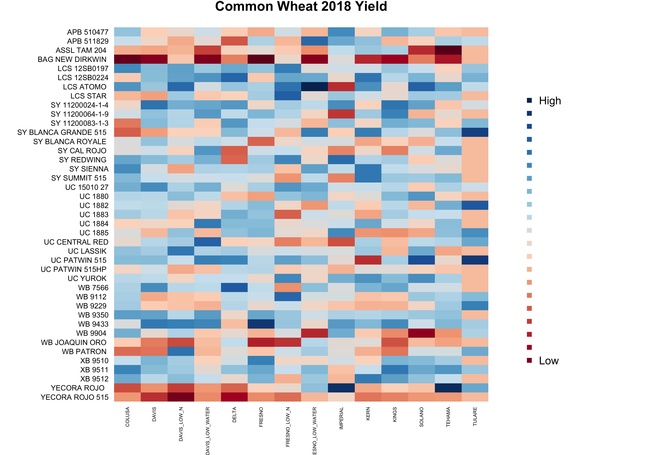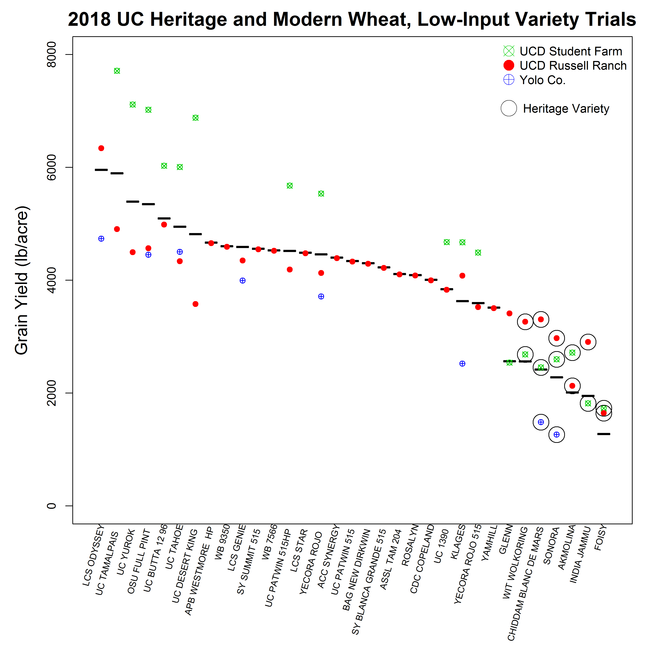The most up-to-date results from the 2017-18 UC Small Grain Variety Testing Program trials as well as trials from previous seasons can be found at the UC Agronomy Research and Information Center Small Grains websites. There are two interactive sites now available to explore UC small grain trial data.
The first site (http://smallgrainselection.plantsciences.ucdavis.edu/) produces regional summaries based on 3 years of trial data using statistical techniques that account for incomplete/unbalanced data across multi-season/multi-location trials. These multi-environment summaries are what we recommend using for making variety selection decisions.
The second site (http://smallgrainselection.plantsciences.ucdavis.edu/explore/) produces simple statistical summaries of trials on a single trial basis across multiple years. These summaries allow more customized exploration of the data and also provide heat map and biplot figures that allow users to examine genotype x environment patterns in the data.
Both sites have features that allow the user to view, filter and sort information interactively. In addition, tables produced at these sites can be downloaded as ‘.csv' files for viewing and manipulation in MS Excel or similar software programs. For the best experience, we recommend viewing these sites using a laptop or desktop computer with an up-to-date version of Firefox, Chrome, or Microsoft Edge web browser (Microsoft Explorer will not work).
The 2018 results currently available at these sites are final yield estimates, but the 2018 protein results will change after calibrating the NIR measurements to a standard (the absolute protein numbers are high, but the relative numbers are correct). In addition, we are still taking test weight and kernel weight measurements. We will update these sites with the remaining data as soon as it is available. In addition, final results from the 2018 trials will be made available as printable ‘.pdf' and ‘.xls' files at http://smallgrains.ucanr.edu/Variety/ in the coming weeks. We will send an announcement out on this blog (https://ucanr.edu/blogs/smallgrains/) at the next round of updates to 2018 results.
Organic/Low-input Small Grain Trial Results
In cooperation with UCCE Advisor Konrad Mathesius, UC Davis small grains breeder Allison Krill-Brown, and farmers in the Sacramento Valley region, 3 trials were conducted in the Sacramento Valley during the 2017-18 season in addition to our annual statewide trial program. These trials consisted of a unique blend of crop types, including both modern and heritage varieties, grown under organic and low-external-input conditions. The goal was to assess productivity potential across a wide range of genotypes in organic production environments. A combined summary of the productivity results from these trials is now available on the UC Small Grains Agronomy Research and Information Center site: http://smallgrains.ucanr.edu/Variety_Results/Organic_Low_Input_2018_Variety_Results/. A subset of these trial entries are also being analyzed for bread making and malting quality.
2016-17 Wheat Quality Results
Historically, the California Wheat Commission Quality Lab has conducted grain and flour quality analyses for common wheat and durum varieties from a subset of UC Small Grain Variety Testing Program trial locations. Over the past year, the California Wheat Commission Quality Lab greatly expanded the number of testing locations for which they produced common wheat grain and flour quality analyses. These expanded results from the 2016-17 trials are now available on the UC Small Grains Agronomy Research and Information Center site: http://smallgrains.ucanr.edu/Common_Wheat_Quality_2017/.
The expanded quality testing has been undertaken as part of the California Wheat Commission's ongoing effort to increase information about California wheat quality and improve the overall quality of California-grown wheat. These results are also contributing to a current effort to create a wheat quality classification system in California. For more information about these efforts, be sure to contact the California Wheat Commission (https://www.californiawheatcommission.org/contact).

